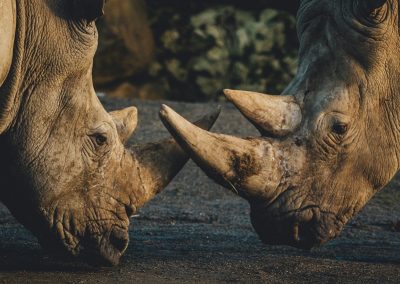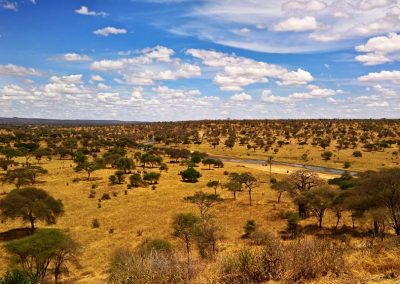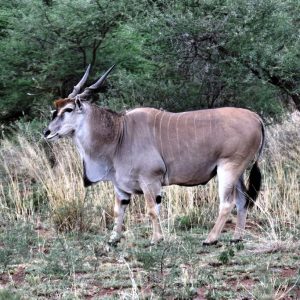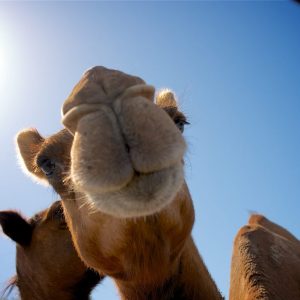6 Days Northern Parks & Culture / Tarangire N. P. – Serengeti – Ngorongoro Crater – Lake Eyasi
- Tarangire: Enjoy tree climbing lions, abundance of elephants, huge baobab trees and termite mounds dotting the hills
- Ngorongoro: Impressive crater landscape, fantastic views, abundance of wildlife and the Olduvai Gorge with the oldest human bone finds
- Serengeti: Breath-taking savanna landscape, highest animal density, wildebeest migration
- Lake Eyasi: Go on an exciting hunting trip with the Hadzabe bushman, a tribe of nomadic hunter gatherers
- Meet members of the Datoga tribe and learn about traditional life
Tour FAQs
- Overview
- Itinerary
- Circuit / Region
- Included Services
- Excluded Services
- Options
- Rates
- Best Time To Travel
- Packing Tips
- Notes
Tarangire National Park is about the size of Luxembourg and is mainly known for its large herds of elephants and its population is estimated at 2500 animals. The landscape is characterized by large Baobabs (monkey bread trees), bush savannah and wetlands and in addition to the many elephants, also Maasai giraffes, gazelles and antelopes, buffalos, lions, leopards, baboons and various species of birds can be seen here.
The Serengeti is especially known for the annual migration of hundreds of thousands of wildebeest and zebras. In October and November, the animals usually migrate from the Maasai Mara in Kenya across the northern Serengeti to the south into the Ndutu area. From May and June, the animals travel across the western Serengeti back to the north into the Maasai Mara. Due to fluctuating weather conditions and the associated rain showers this schedule can be postponed every year. The southern Serengeti is known for its grass savannah with many Kopjes (rock formations). As the landscape is ideal for hunting it is home to large wild cats, such as cheetahs, lions and leopards.
The landscape of the Ngorongoro Crater is characterized by grassy steppes and acacia forests and offers after the endless expanse of the Serengeti with the steep crater slopes a nice change. It is one of the most densely populated African wild areas in the world and is home to an estimated 30,000 animals, including some of Tanzania’s last remaining black rhinos. Flocks of wildebeest, zebras, buffalos, eland antelopes, warthogs, hippos and giant African elephants live here. Another great attraction of this picturesque crater is its huge population of predators, including lions, hyenas, jackals, cheetahs and the ever-elusive leopard. The Ngorongoro Crater is often referred to as “Africa’s Garden of Eden”, “Africa’s 5th Natural Wonder” and takes part of the UNESCO World Heritage Sites due to its impressive abundance of animals.
An hour’s drive west of Karatu is the largest of the slightly alkaline Great Rift Valley Lakes. The impressive crater highlands extend to the northeast, while the wide plains of the Serengeti stretch to the north. Only a few tourists visit Lake Eyasi. Anyone who takes the time is enthusiastic. The landscape, the vastness, the wildness, the reduction to the essentials and finally the life of the people, as we can no longer imagine in Western countries, leave no visitor cold. The area is inhabited by Bushmen, the Hadza and the Watindiga, who still hunt with bows and arrows and collect roots, tubers and fruits. Another tribe in this area are the Datoga, skilled farmers and craftsman collecting scaps of iron, which melt in ingots from which to obtain ornamental objects. In fact, they are skilled smiths and realize arrowheads and other objects that then they barter in exchange for honey and animal skins with the bushmen.
- Day 1: Arusha – Tarangire National Park
After a short safari briefing in the morning, we leave in direction Tarangire National Park. After extensive game drives, we leave the National Park for your booked accommodationMeal plan: lunch, dinner
Possible Accommodations: Fanaka Lodge (budget), Sangaiwe Tented Lodge (mid-range – outside the National Park), Lake Burunge Tented Camp (luxury – outside the National Park), Tangarire Safari Lodge (luxury – inside the National Park)
- Day 2: Tarangire National Park – Serengeti National Park
After breakfast we drive towards the Serengeti. We pass Karatu and drive through the Ngorongoro Conservation Area, past the Ngorongoro Crater. Soon you can see the endless expanse of the Serengeti. On the way to your accommodation in the Seronera area, make your first game drive in the worlds famous Serengeti. You will spend the night in the National Park.Meal plan: breakfast, lunch, dinner
Possible Accommodations: National Park Bandas (budget), Zawadi Camp (mid-range), Kati Kati Tented Camp (mid-range), Lamai Serengeti Camp (luxury), Lemala Nanyukie (luxury)
- Day 3: Serengeti National Park
You will spend the whole day on game drives. In addition to the large migration you will have the opportunity to observe other animals in their natural habitat. Your guide is familiar with the national parks and guides you to the best observation sites. In the late afternoon you return to the camp.Meal plan: breakfast, lunch, dinner
Possible Accommodations: National Park Bandas (budget), Zawadi Camp (mid-range), Kati Kati Tented Camp (mid-range), Lamai Serengeti Camp (luxury), Lemala Nanyukie (Luxury)
- Day 4: Serengeti National Park – Ngorongoro Crater – Karatu
Immediately after an early breakfast we head to the Ngorongoro Conservation Area. On the way to the Park gate you will have the opportunity to observe animals that you have not seen in the past few days. After lunch we continue towards Ngorongoro Crater. You have time to enjoy the breathtaking view over the crater before descending the track into the world's largest caldera. With a little luck you will be able to observe the Big Five, consisting of lion, elephant, buffalo, rhino and leopard, within a few hours. In the afternoon we continue to Karatu in the Ngorongoro Highlands, where you will spend the night.Meal plan: breakfast, lunch, dinner
Possible Accommodations: Crater Rim View Lodge (budget), Eileen’s Trees Inn (budget) / Karatu Lodge (mid-range) /Karatu Tloma Lodge (luxury)
- Day 5: Karatu – Lake Eyasi
In the morning after breakfast we leave towards Lake Eyasi. After check—in relax in the Lodge and lunch. After lunch we will meet members of the Datoga tribe. We will see how they work and visit a Datoga home and learn, how the woman in traditional clothes prepare food for their family, milling flour.
In the late afternoon we enjoy scenic views of Lake Eyasi and watch the sunset from the shore before heading back to the accommodation.Meal plan: breakfast, lunch, dinner
Possible Accommodations: Sonayi Safari Lodge (mid-range) / Kisimangeda Tented Camp (luxury)
- Day 6: Lake Eyasi – Arusha
Early in the morning, before breakfast we are leaving to meet the Hadzabe tribe, the last hunter-gatherer tribe of Tanzania. We will accompany them for hunting, watch their daily activities and practice ourselves making fire and shooting with the bow.After lunch we will leave in direction Arusha, where you will arrive in the afternoon. Your exciting safari ends in the city or at one of the airports (Arusha / Kilimanjaro).
Meal plan: breakfast, lunch
Info:
Please note that: If you would like to experience the wildebeest migration, we will select and recommend a camp in the category of your choice. If you are traveling between early January and mid-March, you should stay in the southern part of the Serengeti or in the area adjacent to the Serengeti within the Ngorongoro Conservation Area, as this is when the zebra and wildebeest herds will be there. From June/July they move towards the northern half of the Serengeti.
- Transport from and to your hotel/residence or airport/seaport
- Professional, English-speaking driver/guide
- All activities as per itinerary
- All accommodations and meals as mentioned in the itinerary or as agreed. N. B. accommodation mentioned in the itinerary is dependent on availability at the time of booking; alternatives of a similar class may be booked instead
- All camping gear (if applicable)
- 4 × 4 safari vehicle with pop up roof for game viewing (if applicable)
- Drinking water during the game drives/walking safaris
- Driver’s salary and allowances
- All National Park entrance fees, nature trail and community fees
- International/national flights and visa fees
- Extras, personal expenses i.e. soft- and alcoholic drinks, telephone, souvenirs, laundry etc.
- Travel, medical, injury and luggage insurance
- Flying doctor rescue services
- Government-imposed increases in taxes and/or park entrance fees
- Tips to the driver & guide
- Anything else not mentioned in the inclusions
- Optional activities not outlined on the itinerary
- Visiting the Olduvai George (one of the most important paleoanthropological sites in the world)
- Instead of Tarangire N. P. you can choose Lake Manyara N. P.
- The whole tour can also be done as a camping safari
- Additional accommodation before and after the tour can be arranged for an extra cost
- Extension of stay or additional program is possible / or have a look at our other offers
- The dry season between June and October is considered the best time for a safari, but you can also expect good weather in the summer dry season between December and February.
- The wildebeest migration in the Serengeti takes place between July and October. In July, the animals first cross the Grumeti River, followed by the spectacular crossing of the Mara River.
- Between late January and March, over 500,000 calves of the wildebeest are born (that’s 8,000 every day!) and gangly babies dot the landscape.
- Usually our tours require a minimum of 2 persons to run. Single travelers can join a tour or ask us for a tailor-made safari.
- We offer discounted prices for children.
Are you ready to explore Africa?
This itinerary is an example of tours we organize.
Contact us by email, WhatsApp or phone to create your individual trip or choose one of our itineraries without obligation!
-book now-














